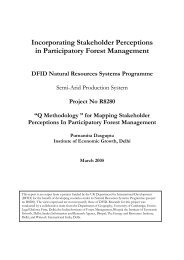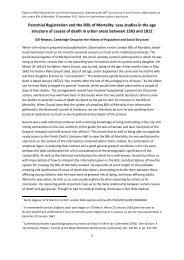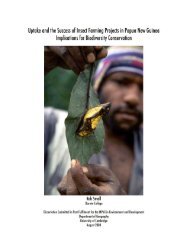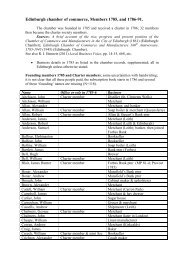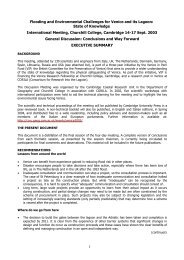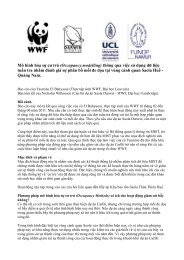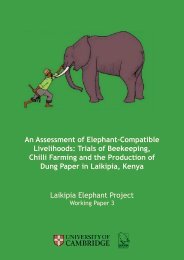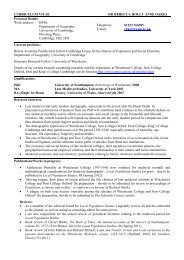Laikipia Elephant Project Working Papers - University of Cambridge ...
Laikipia Elephant Project Working Papers - University of Cambridge ...
Laikipia Elephant Project Working Papers - University of Cambridge ...
Create successful ePaper yourself
Turn your PDF publications into a flip-book with our unique Google optimized e-Paper software.
Introduction<br />
Human-elephant conflict, where elephants damage crops and property and occasionally injure<br />
and kill people, and where people retaliate by injuring and killing elephants, has emerged as<br />
the greatest challenge to the conservation <strong>of</strong> elephants in Africa in the absence <strong>of</strong> commercial<br />
poaching for ivory (Thouless 1994; Kangwana 1995). The problem <strong>of</strong> human-elephant conflict is<br />
complicated in that elephants can be extremely destructive pests while at the same time they<br />
are listed as endangered under CITES, and are therefore afforded considerable protection by<br />
national governments (Hoare 2000). This creates tension between human victims <strong>of</strong> human-elephant<br />
conflict on the one hand and conservationists on the other, including national wildlife<br />
authorities, undermining wider programmes <strong>of</strong> biodiversity conservation and community support<br />
(Lee and Graham 2007).<br />
A number <strong>of</strong> approaches have been used to address human-elephant conflict including destroying<br />
problem elephants, the construction <strong>of</strong> various barriers (moats and electrified fences) and<br />
translocation <strong>of</strong> elephants (Hoare 1995; Thouless and Sakwa 1995). Alongside these centralised<br />
interventions, there are also traditional methods that farmers use to defend their crops from<br />
elephants such as lighting fires, making loud noises and throwing various kinds <strong>of</strong> missiles (Sitati<br />
et al. 2005; Ochieng 2008). Due to the expense and frequent failure both the sophisticated and<br />
traditional methods used for HEC mitigation (Hoare 2001), HEC researchers have recently called<br />
on practitioners to focus efforts on supporting small-scale farmers to take up and implement<br />
simple and affordable farm-based crop-raiding deterrents that enhance and compliment traditional<br />
deterrents used (Osborn and Parker 2003). While there is some evidence to suggest that<br />
such simple farm-based crop-raiding deterrents can be effective (e.g. Sitati et al. 2005; Sitati<br />
and Walpole 2006), there are still very few studies published on trials <strong>of</strong> such deterrents and it is<br />
possible that enthusiasm for this approach has outpaced scientific and social understanding <strong>of</strong> its<br />
efficacy (though see Hedges and Gunaryadi 2009).<br />
With a view to better understanding<br />
the effectiveness<br />
and uptake <strong>of</strong> farm–based<br />
deterrents, trials were<br />
conducted in three sites<br />
suffering from crop-raiding<br />
by elephants on the <strong>Laikipia</strong><br />
plateau, in north-central<br />
Kenya between 2002 and<br />
2006 (Fig.1). The positive<br />
responses from the farmers<br />
involved, together with<br />
levels <strong>of</strong> uptake <strong>of</strong> some <strong>of</strong><br />
the deterrents used, suggests<br />
that this approach does<br />
indeed have merits (Graham<br />
and Ochieng 2008, Nyumba<br />
2009). However the results<br />
from the trials in terms <strong>of</strong><br />
actual numbers and levels<br />
<strong>of</strong> damage were not entirely<br />
conclusive, largely as a result<br />
<strong>of</strong> the trial design which was<br />
participatory rather than<br />
experimental.<br />
Figure 1 Deterrence Trial Site 2007<br />
Previous Trials:<br />
1. Ol Moran (Feb to Nov 05)<br />
2. Mutara (June to Dec 02)<br />
<strong>Laikipia</strong> <strong>Elephant</strong> <strong>Project</strong> <strong>Working</strong> Paper 5 / Page 2




